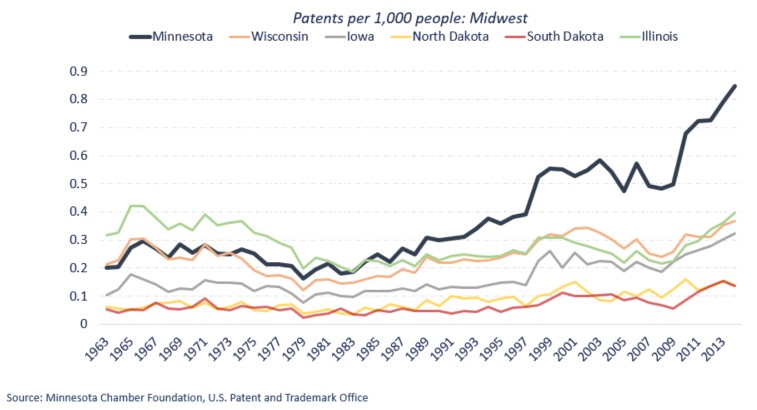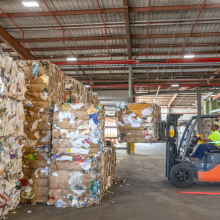Blueprint: Innovation and workforce: Key strengths
Rely on economic strengths
There are several recognized strengths of Minnesota’s economy that should be relied upon to spur short- and long-term growth.
Continue to focus on innovation
Policies to increase and encourage investments in new equipment; to fund new products and services; to fund start-ups and expansions will be critical both for Minnesota’s economic recovery and for our long-term success. Minnesota is known as innovative, ranking 7th in Milken Index Technology and Science Index and 6th best in patents per capita. However, Minnesota ranks low on entrepreneurship, at 49th in the nation for the percent of the population starting a business according to the Kauffman Index. Private sector investment will be essential to help Minnesota recover from the devastating economic impacts of the COVID-19 pandemic.

In the short term, priority should be on encouraging investments in productivity and innovation, such as the following.
Retool existing economic development programs to focus on improving productivity and innovation – for example. This could be grants for robotic upgrades or technology investments to help growth of existing businesses and job retention versus old models of job creation. The guidelines for the incentives should focus on maintaining current employment levels and not result in eliminating jobs.
Reduce barriers for businesses to invest in new equipment and technologies that increase output by reducing regulatory barriers and reducing permit delays.
Leverage suppliers and resources that help businesses implement productivity and digital strategies. COVID-19 has accelerated digitalization and automation in businesses across industries and sizes. Such strategies are particularly imperative for small businesses that have lacked digital capabilities, such as e-commerce platforms. Programs like the Chamber’s MN Supplier Match shine a spotlight on the suppliers Minnesota businesses can turn to for help with their digital or automation needs. Additionally, business mentorship and peer learning programs may help smaller firms navigate such strategies.
Targeted retention strategies to the state’s fastest growing firms may help spur job creation in the short term while seeding the ground for the state’s future Fortune 500 companies.
Increase efforts to support start-ups and early stage businesses. New business filings have risen dramatically in 2020. Strategies to provide technical and financial assistance may pay dividends through new tax revenues, jobs, innovation, and wealth creation. Policies aimed at reducing the barrier to entrepreneurship and spurring new business investment can play an additional role.
Spur hiring and remove barriers to employment
Many businesses are hiring and many of those are reporting difficulty in hiring even in this time of inflated jobless rates. According to the Minnesota Department of Employment and Economic Development (DEED), there are 2.4 unemployed persons for each vacancy (second quarter 2020 data). This is a big turnaround from pre-pandemic where there were more job vacancies than active job seekers.
There is more work needed to help workers navigate current job opportunities and help employers find the employees they need.
Expand and better target workforce career centers and job sites to more efficiently connect workers and employers. An example is an initiative announced by DEED with their #GoodJobsNow campaign to highlight Minnesota businesses who are hiring right now for quality jobs.
Reorient workforce development programs toward the immediate needs of a post-COVID-19 response. For example, demand for IT skills may accelerate both in the short-term – as more businesses shift to digital strategies in light of the pandemic – and in the long-term – as digital technology reshapes existing industries from food production to financial services to retail, and everything in between.
Ensure that public safety nets do not result in undermining incentives to participate in the labor force or put the burden of financing these programs solely on employers.
Expand programs to encourage labor force participation and hiring in underrepresented groups. Delivering on the promise of racial equity is an imperative for Minnesota businesses and essential to rebuilding a post-COVID-19 economy that improves the lives of all Minnesotans. This includes doubling down on proven strategies that connect employers to diverse talent, particularly in high-demand jobs and sectors.
Leverage new opportunities to connect individuals to job opportunities through remote work. This includes increasing access to broadband for underserved and unserved households and businesses through additional public and private investment in this much needed infrastructure. Increasing access to high-speed broadband can both spur short-term recovery and provide an essential building block to long-term development of the state’s economy.
Reduce barriers to workforce participation. A critical immediate concern is child care as a shortage of available early care has the potential to impede economic recovery in many communities. Prior to the COVID-19 pandemic, Minnesota’s working parents were facing a severe shortage of quality child care. Now, decreased capacity and new pandemic-related costs mean operating losses for child care providers that may result in more closures and even less available early care and education options. In direct response to COVID-19, additional funding is needed to meet the needs of low-income and essential workers and their providers. This should be one-time and targeted supplemental funding due to the pandemic and policymakers should seek to maximize the use of federal funds for this purpose. Early learning scholarships in particular help low-income children access high-quality providers. Incentives for employers should be immediately considered to support quick and innovative ways for employers to address child care issues within their own or their community’s workforce.
Help local communities foster collaboration between workforce training/education institutions and the local business sector to prepare people for jobs and skills in highest demand.
Minnesota’s Economic Strengths
HIGH VALUE
Per capita income, GDP per capita and labor productivity levels.
HARD WORKING
Labor force participation and lowest unemployment rates in the United States.
EDUCATED AND SKILLED WORKFORCE
Education levels and concentrations of highly-skilled workers.
INNOVATION
High rate of patent activity.
CORPORATE HUB
Fortune 500 headquarters and industry-leading firms.
DIVERSE ECONOMY
Jobs spread across major industry sectors.
INDUSTRY CLUSTERS IN KEY SECTORS
Health care and medical technology, food and agriculture, headquarters, finance and insurance and high-tech.








